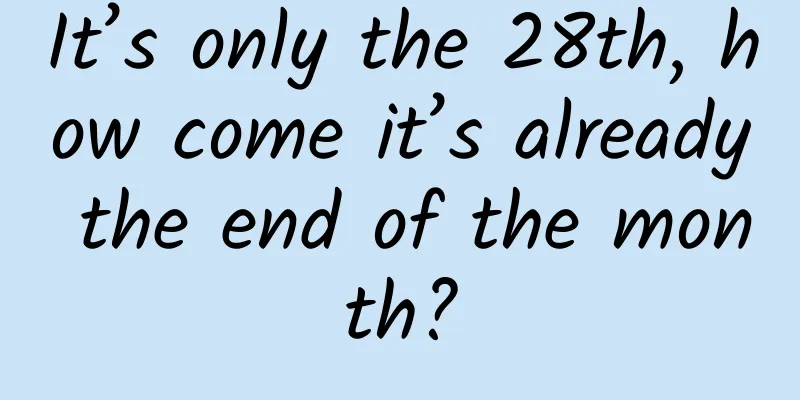It’s only the 28th, how come it’s already the end of the month?

|
Those who were born on February 29th must have had this worry: Why can others celebrate their birthdays every year, but we have to wait four years to have one? Later, through the knowledge of the Gregorian calendar learned in textbooks, we knew that February only has 28 days in an ordinary year, and 29 days in a leap year. Only years that are divisible by 4 and 400 in the case of a century year are leap years. Therefore, friends born on February 29 can only celebrate their birthdays once every four years. In fact, behind these calendar regulations is people's continuous exploration and attempt to improve the calendar. 1. What is the calendar? In the Neolithic Age about 10,000 years ago, people transitioned from hunting and gathering to primitive agriculture and animal husbandry. Since livestock have a certain breeding period, the sowing, growth and harvesting of crops have a certain regularity, so based on the needs of production, the primitive calendar was created. People have the concept of day based on the rising and setting of the sun and the alternation of day and night; they have the concept of month based on the waxing and waning of the moon; they have the concept of year based on the changing seasons and the growth and withering of plants. The calendar is a law that calculates the length of years, months and days and the relationship between them, and formulates a time series. In the early days, the "year" determined based on phenology was affected by abnormal meteorological factors and fluctuated greatly, so it was impossible to accurately determine the number of days in a year. Later, people summarized the relationship between astrological changes and seasons and climate, and then accurately gave the number of days in a year. The calendar based on this was the astronomical calendar. The astronomical calendar combines the movement of the sun and the moon, and arranges dates by formulating reasonable rules based on the day, the new moon, and the tropical year. Due to differences in cultural history and other factors in different regions, many different calendars have been born from ancient times to the present, from the East to the West. We can classify the calendars according to their characteristics and roughly divide them into three types: the solar calendar, the lunar calendar, and the combined solar and lunar calendar. solar calendar The solar calendar is a calendar based on the periodic changes of the sun caused by the earth's revolution. The solar calendar is based on the time it takes for the earth to orbit the sun, so it strengthens the concept of the year, while the length of the month is usually not so strict. In this case, the solar calendar has a very accurate grasp of the seasons, and a certain season corresponds to a specific period of time. Historically, the Gregorian calendar first appeared in ancient Egypt 6,000 years ago. At that time, people determined the length of a year based on the astronomical phenomenon of Sirius rising with the sun (that is, Sirius rising above the horizon just before dawn) and the cycle of the Nile River flooding. The Gregorian calendar that everyone is familiar with is the solar calendar, so we sometimes habitually call it the "solar calendar." Sirius rises with the sun, Stellarium simulation lunar calendar Also known as the lunar calendar. The moon is the moon. As the name suggests, the lunar calendar is a calendar that is mainly formulated according to the changes in the moon phase cycle. Since the average cycle of the moon phase change is about 29.5 days, the lunar month is divided into a long month and a short month, with a long month of 30 days and a short month of 29 days. Among the calendars still in use, the Islamic calendar is a pure lunar calendar. The Islamic calendar stipulates that there are 12 months in a year, with 30 days in odd months and 29 days in even months. There are 12 months in a year, and 11 leap years are set every 30 years, with one day added after the 12th month (this is similar to our Gregorian calendar, with one day added in leap years). In this way, the length of the 30-year Islamic calendar and the total number of days in the 30-year synodic month are basically equal. Calculated in this way, the average length of a year is 354.37 days, which is about 11 days different from the actual tropical year, resulting in a difference of one month every 2.7 years. Therefore, there is no correspondence between seasons and months in the Islamic calendar. Lunar-solar calendar Also known as the lunar-solar calendar, it is a calendar that contains both solar and lunar calendar content. Specifically, the length of the month is kept consistent with the cycle of the synodic month, while the length of the year is kept consistent with the average value of the years and the period of the earth's revolution around the sun. This arrangement allows the "month" to intuitively reflect the changes in the moon phases, while taking into account the corresponding relationship between the month and the season. my country's traditional calendar, the "Lunar Calendar", is one of the representatives. The lunar month starts with the new moon day, which reflects the relationship with the moon phase. The 24 solar terms reflect the movement of the sun. In the lunar calendar, there are 12 synodic months in a normal year, about 354 days long, and 13 synodic months in a leap year, about 384 days long. On average, there are 7 leap years in every 19 years. In the lunar calendar, we can intuitively see the moon phase information, such as the saying "the moon is full on the 15th and the 16th"; the leap year also prevents the months and seasons from being confused, such as this year's leap February in the lunar calendar. For details on the relevant specifications of the lunar calendar, please refer to the national standard "Compilation and Issuance of the Lunar Calendar" (GB/T 33661-2017) (drafted by the Purple Mountain Observatory of the Chinese Academy of Sciences, the only calendar compilation institution in China). The second month of the lunar calendar this year (Image source: Purple Mountain Observatory) Generally speaking, the three calendars have their own characteristics, but no matter which one, there is scientific knowledge behind it, which is why the three calendars are used in regions around the world. 2. Calendar Reform: Julian and Gregorian The Gregorian calendar is the calendar used in the world today. It was promulgated by Pope Gregory XIII in 1582, so it is also called the Gregorian calendar. The Gregorian calendar is an improvement on the Julian calendar. The Julian calendar was promulgated and implemented by the Roman ruler Julius Caesar on January 1, 45 BC. It uses the tropical year as the basic unit and divides the year into 12 months. Odd months are long months with 31 days, and even months are short months with 30 days. Only February has 29 days in a common year and 30 days in a leap year. There are 365 days in a year, and a leap year has 366 days every four years. After the Julian calendar was compiled, Augustus, the successor of Julius Caesar, subtracted one day from February and added it to August to make August a long month. He also changed September and November to short months, and October and December to long months. Bust of Julius Caesar (Source: Wikipedia) The Julian calendar is a solar calendar with an average annual length of 365.25 days. However, in fact, the length of the two times the sun passes through the spring equinox (tropical year) is 365.2422 days, a difference of 0.0078 days. This 0.0078 days may seem small, but if it is implemented for a long time, it will cause a difference of one day every 128 years. The Julian calendar set the spring equinox on March 21 in 325 AD. In 1582, more than 1,200 years after its implementation, the spring equinox was advanced to March 11. In order to solve the inherent deficiencies of the Julian calendar, the Gregorian calendar was modified on the basis of the Julian calendar. The modification mainly modified the leap year part of the Julian calendar, changing the original leap year every 4 years to every year that is divisible by 4, but the century year must also be divisible by 400 to be a leap year (for example, 1700, 1800, and 1900 are not leap years, but 2000 is a leap year). After Gregory's modification, there are 3 fewer leap years than the Julian calendar every 400 years, and the average length of the year becomes 365.2425, which is only 0.0003 days away from the actual length of the tropical year. It takes about 3,300 years of continuous use to make a difference of one day. Pope Gregory XIII (Image source: Wikipedia) Interestingly, in order to determine the vernal equinox around March 21 again, the Gregorian calendar stipulated that the day after Thursday, October 4, 1582 would be Friday, October 15, 1582, that is, 10 days were deleted , but the original order of the week remained unchanged. It is worth noting that the average annual length (Sui Shi) determined by the Tongtian calendar during the Southern Song Dynasty in my country is the same as the tropical year of the current Gregorian calendar, but it was more than 300 years earlier than the implementation of the Gregorian calendar. The revised Gregorian calendar was more accurate than the Julian calendar and was gradually adopted by Western Christian countries, and later became the international calendar. It can be said that the replacement of the Julian calendar by the Gregorian calendar was a scientific legislative reform, and it was this reform that laid the foundation for the international calendar system we have today. From the ancient Egyptian Sirius rising with the sun to the Gregorian calendar replacing the Julian calendar, every reform and development of the calendar reflects people's respect for the natural movement of celestial bodies and their emphasis on formulating a calendar that closely matches the movement of the sky to serve the needs of the people. Behind this are the observations and arduous explorations of countless astronomers day and night. Author: Sun Hengyang, Engineer at Qingdao Observatory, Purple Mountain Observatory, Chinese Academy of Sciences |
<<: To control post-meal blood sugar, drinking coffee with sugar and milk is more effective?
>>: Amazing marine diatoms! Scientists discover new mechanism of diatoms using light energy
Recommend
The third trick of the three crazy demolitions to make money: How to make money with WeChat emoticons? How to earn over 10,000 yuan a month from your side job
Course Description Plan 1: Analysis of new etique...
Which fruits are not sweet but can easily make people gain weight?
Hot weather, no appetite Have some fruit Some peo...
Hot search! Are there fewer lychees this year? Here's how to achieve "lychee freedom" →
In the hot summer, eating a lychee is sweet and r...
Will eating too much MSG give you a headache? "MSG is misunderstood" sparks heated discussion
If salt is the saltiest seasoning in your home, t...
What are the first principles of a viral product?
Dali Ge and Qian Gewara, which are produced by th...
Tesla slashed its prices in the US because BYD’s sales have surpassed its own?
On January 8, Tesla lowered the prices of some mo...
Fortune telling, why is it getting more accurate? Uncovering the common practices of "predestination metaphysics"
Image source: Tuchong Creative Why does fortune-t...
If you don’t even understand the 10 principles of psychology, you are really not qualified to talk about marketing
With the rise of digital marketing , marketers mu...
Social media marketing, just start from these 3 points!
Social media marketing has become the standard fo...
Why are there "colorful lights" hanging in the fields? It turns out that it is a "trap" set for them...
When we walk along the country roads, we sometime...
20 Social Marketing Growth Strategies for 2021
In 2021, social marketing occupies a very critica...
Lenovo brand Sharp manufacturing - Lenovo Smart TV S9 "Terminator" is in good condition
Lenovo smart TV is here with the attitude of a &q...
In-depth understanding of OC/C++ closures
Author: Cui Xiaobing background Apple's Objec...
If this symptom occurs in the arm, it may be a sign of a heart attack!
Mention of myocardial infarction I believe many p...
Want your child to grow taller? Huaxi experts teach you how to do this...
A previous survey by the World Health Organizatio...









